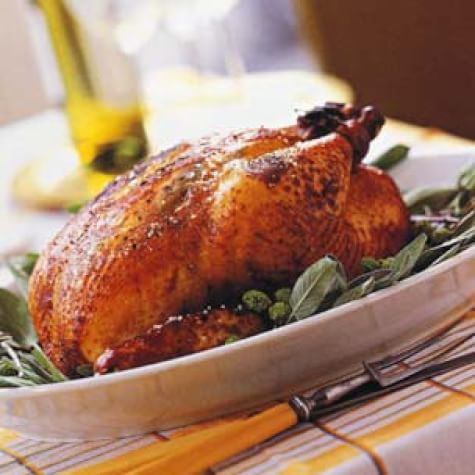
Roast Chicken with Balsamic Vinegar and Sage (Pollo Arrosto al Balsamico)
Roast Chicken with Balsamic Vinegar and Sage (Pollo Arrosto al Balsamico) is rated
out of
5 by
1.
Prep Time:
10 minutes
Cook Time:
90 minutes
Servings:
6
Serves 6.
The finest balsamic vinegar is made from the must of a white wine grape, the Trebbiano. It is cooked down and then aged in barrels made of different kinds of aromatic woods, such as chestnut, cherry and mulberry, which impart their unique flavors to the vinegar. Many homes in the countryside of Emilia-Romagna have an acetaia, an attic room devoted to storing the vinegar barrels. At least 12 years of aging are required to make genuine aceto balsamico, and only the finest specimens are permitted to be called aceto balsamico tradizionale di Modena. These artisanally made vinegars are quite expensive and are meant to be drizzled over foods, such as fresh strawberries or Parmigiano-Reggiano, or used sparingly as a condiment. The very finest are sometimes sipped as a cordial. At one time it was believed that balsamic vinegar could alleviate some of the pain of childbirth, so small amounts were given to expectant mothers during delivery.
For cooking purposes, the less expensive commercially made balsamic vinegars will suffice. They add a pleasant sweet-tart lift to sauces and soups and form a lovely brown glaze on grilled meats and poultry.
For cooking purposes, the less expensive commercially made balsamic vinegars will suffice. They add a pleasant sweet-tart lift to sauces and soups and form a lovely brown glaze on grilled meats and poultry.
Ingredients:
- 1 chicken, about 5 lb.
- 12 fresh sage leaves
- 2 large garlic cloves, chopped
- 2 Tbs. olive oil
- 2 Tbs. balsamic vinegar
- 1/2 tsp. sugar
- Salt and freshly ground pepper, to taste
Directions:
Preheat an oven to 350ºF.
Rinse the chicken and pat dry. Tuck the wings behind the back. Using your fingers, gently loosen the skin on the breast and legs, being careful not to tear the skin. Insert a few of the sage leaves and some of the garlic under the skin, distributing them evenly. Pat the skin firmly back in place. Tuck the remaining sage leaves and garlic into the cavity.
In a small bowl, whisk together the olive oil, vinegar, sugar, salt and pepper. Rub some of the mixture over the chicken and pour the remainder inside the cavity. Cross the drumsticks and, using kitchen string, tie the legs together. Place the chicken, breast side up, on a rack in a roasting pan.
Roast the chicken, basting occasionally with the pan drippings, until an instant-read thermometer inserted into the thickest part of the thigh, away from the bone, registers 170ºF and the juices run clear when a thigh is pierced, about 1 1/2 hours.
Transfer the chicken to a carving board and cover loosely with aluminum foil.
Pour the pan juices through a fine-mesh sieve into a small saucepan. Skim off the fat. Reheat to serving temperature, if necessary.
Carve the chicken and arrange on a warmed platter. Pour the pan juices over the chicken and serve immediately.
Rinse the chicken and pat dry. Tuck the wings behind the back. Using your fingers, gently loosen the skin on the breast and legs, being careful not to tear the skin. Insert a few of the sage leaves and some of the garlic under the skin, distributing them evenly. Pat the skin firmly back in place. Tuck the remaining sage leaves and garlic into the cavity.
In a small bowl, whisk together the olive oil, vinegar, sugar, salt and pepper. Rub some of the mixture over the chicken and pour the remainder inside the cavity. Cross the drumsticks and, using kitchen string, tie the legs together. Place the chicken, breast side up, on a rack in a roasting pan.
Roast the chicken, basting occasionally with the pan drippings, until an instant-read thermometer inserted into the thickest part of the thigh, away from the bone, registers 170ºF and the juices run clear when a thigh is pierced, about 1 1/2 hours.
Transfer the chicken to a carving board and cover loosely with aluminum foil.
Pour the pan juices through a fine-mesh sieve into a small saucepan. Skim off the fat. Reheat to serving temperature, if necessary.
Carve the chicken and arrange on a warmed platter. Pour the pan juices over the chicken and serve immediately.
Serves 6.
Adapted from
Williams-Sonoma Savoring Series,
Savoring Italy,
by Michele Scicolone
(Time-Life Books, 1999).
Rated 5 out of
5
by
RozandTom from
Easy and perfect -
For something new and delicious try this recipe. It is wonderful. Dried sage works fine as I have tried it both ways. This is both a great dish for the weekend or for entertaining (as it is very impressive). When most all the meat is off the bone, I boil down the leftovers with a couple of cans of chicken broth with a tablespoon of Balsamic Vinegar and teaspoon of sugar. It makes the most delicious broth to freeze or serve for lunch. Perfect recipe for the novice cook. Enjoy!
Date published: 2012-06-01










